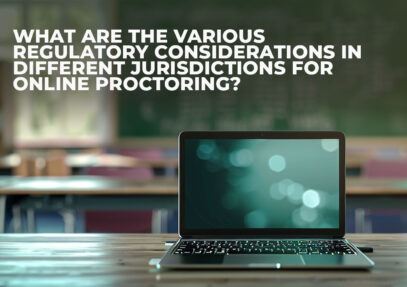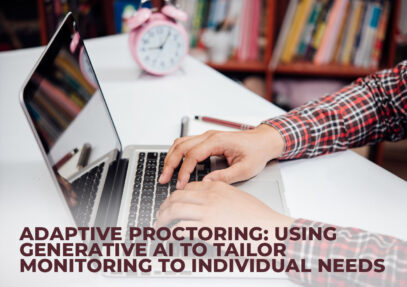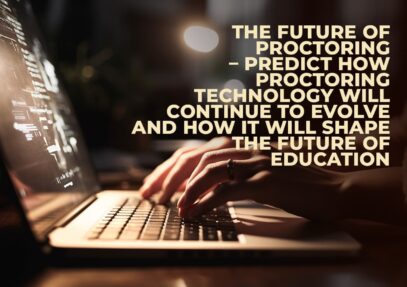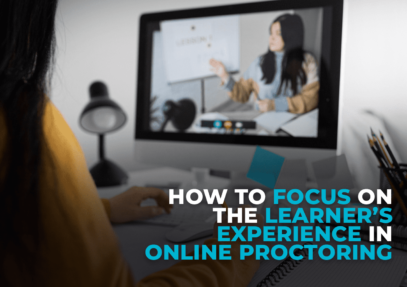
2020 was a year of dramatic change for colleges and universities. For many, a gradual shift toward online education and digitally-enabled classes that was years in the making was suddenly accelerated by the global pandemic. In addition to the inherent uncertainty of processes and timelines, this shift introduced technical challenges and emotional stress for many students.
As the world transitions to a post-pandemic reality, online examinations are clearly here to stay, along with online, or remote proctoring. With all the “buzz” about AI-based proctoring and myths of online proctoring, we are constantly hearing real stories of students feeling uncomfortable about online-proctored examinations.
The future success of online proctoring is dependent upon keeping the student at the center of this transformation. In such a learning environment, how do universities or education and training institutions focus on improving the learner’s experience and making them more comfortable with the new mode of exam-taking?
5 Ways To Make Online Proctoring Comfortable For Test Takers
For both live and recorded modes of online proctoring, most students consider the method to be intrusive when it takes place in one’s own home rather than in an examination hall. To help make online proctoring less intrusive and more comfortable for exam candidates, below are a few suggested practices:
1. Employ Experienced Proctors
An online, or remote, proctor serves the purpose of verifying the student’s identity and monitoring their immediate environment with the help of a webcam. Experienced proctors are trained to detect “suspicious” student behavior (like unusual eye movements) or the use of any unauthorized aids or devices that could enable cheating.
For the best results, educational institutions must employ experienced proctors who are trained in online proctoring techniques. With such proctors, exam candidates are likely to be more comfortable, because the remote proctoring experience would more closely resemble their in-person exam hall experience.
2. Combine Technology With Human Proctors
While technologies like Artificial Intelligence (AI) are a good fit for remote proctoring, hybrid proctoring methods that combine technology with human proctors can be even more effective at ensuring the learner’s comfort. Exam takers would be more aligned with the prospect of their exam scoring and ethics being evaluated by both technology and humans instead of relying on technology alone.
This can reduce students’ concerns about false flagging of suspicious behavior and incorrect answers. Universities and institutions can help their students get used to technology through trial exam sessions or troubleshooting guides for any technology-related problems that students could face during their online exam sessions.
3. Lower Student Anxiety Through Familiarizing
Dylan Singh, a student at the University of Southern California, mentions, “the sudden use of online proctoring is the biggest anxiety factor – as the emphasis isn’t on us showing our learning, it’s on not getting caught.” For remote learning students (used to working with book-based instructions and questions), taking an online exam can be a stressful and anxiety-causing experience.
The best countermeasure is to familiarize students and lower their anxiety levels by:
- Being open and transparent with both students and instructors about their online proctoring methods.
- Conducting more frequent online exams (throughout the entire term or semester) to familiarize students with the process.
4. Ensure Data Privacy
There is a growing emphasis on the privacy of student data in relation to online proctoring. While some personal information is necessary to authenticate students, educational institutions should work with proctoring service providers to determine:
- How much student data is necessary for authentication (and nothing more)?
- How to keep the collected data safe and secure?
- How long should the student information be stored before being deleted?
Instead of a separate student account, integrating the proctoring system with an existing learning management system (LMS) can be a better solution for safe data transmission and addressing privacy concerns.
5. Use Browser Lockdown
Besides data privacy, student privacy is another growing concern in online proctoring. Effectively, this means the level of autonomous access that an online proctor has to the student’s device. Instead of providing full remote access (where proctors can access local files and folders), opt for the less intrusive browser lockdown that can ensure fair testing without infringing on the student’s privacy.
A browser lockdown has limited applicability and can prevent unfair practices like copying-pasting content, using instant messaging, or browsing external sites. Further, students can easily download and implement browser lockdown, as well as disable it once the examination is complete.
Along with addressing student concerns about online proctoring, universities, and educational institutions should dispel some common online proctoring myths.
Myth 1 – Proctoring Companies Access Student Devices After Exam Completion
We continue to hear stories about proctoring service companies continuing to access the student’s devices even after completing the online exam. Typically, this includes viewing the browsing history and account page credentials.
To counter this myth, students must be educated on how their data is being collected and till when they are retained. For clarity, provide them with clear answers about:
- How to uninstall the proctoring tool (or software) after the online assessment?
- Who to contact if they have any privacy-related concerns?
- How to determine if their sessions are being recorded following an online exam?
Myth 2 – Every Proctoring Method Includes Live Video
Another popular misconception among students is that they are constantly being visually monitored by online proctors using smart webcams or surveillance devices. The reality is that there are different types of remote proctoring methods and not all of them involve the use of video-capturing technologies. To eliminate this misconception, students must be informed about the type of proctoring methods that they are going to experience.
Myth 3 – Loss Of Student Privacy
Do students completely lose their privacy with online proctoring? No, the reality is that students are always in complete control of their physical environment. In addition, they can take a few precautionary measures to maintain control over their privacy, including:
- Removing any personal items like family photos from the testing environment.
- Taking the online exam in a private space without the presence of any other person.
- Wearing appropriate clothing during the exam duration.
Conclusion
Despite the innumerable benefits of online examinations and remote proctoring, students are often justified in raising concerns about data privacy and intrusive technologies. For this reason, universities adopting remote exam proctoring must focus on elevating the student’s experience and addressing their concerns.
As a provider of online proctoring solutions, EnFuse Solutions can be your partner for improving your students’ online test-taking experiences. To learn more, contact us today.

















Comment